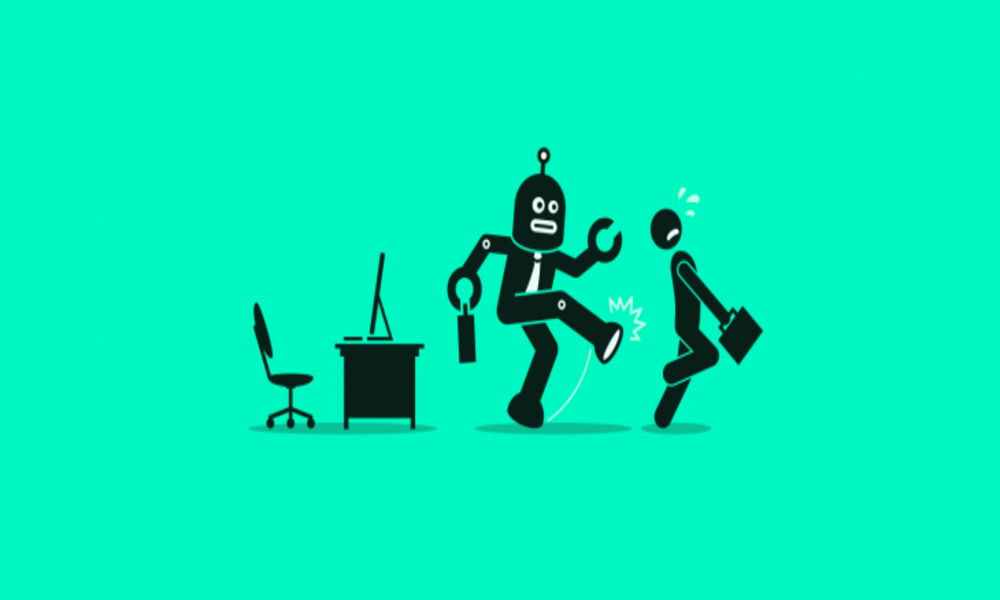
SAVR KUMAR – APRIL 2ND, 2020
EDITOR: CHAZEL HAKIM
Robots are increasingly taking over avenues of employment. We see them behind fast food counters as cashiers and in the sky as drones. Technologists and economists have forewarned that economies are reaching a point where human employment may soon be affected, as machines’ capabilities aggressively expand while ours largely remain the same. Will robots supersede us in most if not all areas of employment? Will this mean that formerly employed workers will have no other options to resort to? There is no conclusive proof of what may become of the job market, but there is certainly a lot of apprehension surrounding the issue. Many people fear that machines may usher in a new era in which humans work ceases or one in which they complement it.
The trepidation that surrounds job automation is not a recent phenomenon. Ever since the industrial revolution, people have been concerned about their job security due to ever-advancing technology. An eighteenth century group known as the Luddites, for example, destroyed machinery that reduced the need for their labor. In hindsight, we know that their fears were unfounded since employment and productivity rose throughout the 19th and 20th centuries. The term luddite is now used as an insult today towards people who are unfamiliar with and/or incapable of using technology well and acknowledging its benefits, the title “Luddite Fallacy” signifies the idea that human work may significantly decline due to technological advancement There is now concern that the so-called Fallacy may have some validity. For example, Larry Summers, president of Harvard University and director of the White House’s National Economic Council, recently changed his views on the matter: “Until a few years ago, I didn’t think this was a very complicated subject; the Luddites were wrong and the believers in technology and technological progress were right. I’m not so completely certain now.”
According to a 2013 University of Oxford Study, 47% of the people employed in the United States are at risk of becoming unemployed due to automation in the next decade or two. Transportation, administrative jobs, and logistics were identified as the most vulnerable occupations. Some of the most common professions in developed nations such as the US are cashiers, retail salesmen, office clerks, and drivers. These jobs account for nearly half the jobs in the economy. To contextualize the magnitude of a 47% unemployment rate, during the Great Depression the unemployment rate was 25%, accounting for one fourth of the jobs in the economy.
Derek Thomson, a senior editor at the Atlantic, further discusses that this argument must be taken more seriously due to the increasing dominance of capital over labor, the spread of underemployment and the formidable dexterity of information technology. The share of US GDP paid out in wages stands at its lowest since the mid-twentieth century, a phenomenon some attribute to globalization and decreasing bargaining power for some workers. On the other hand, there is increasing reliance on automation, big data analytics, machine learning and robotics. Loukas Karabarbounis and Brent Neiman, economists at the University of Chicago, believe that it can be attributed largely to businesses’ tendency to replace workers with computers and software. This argument can be illustrated by comparing Google today versus AT&T in 1956. The latter was the most valuable company in the world at that time and employed 758,611 people. Its current day counterpart, Google, has only about 55,000 employees, which is less than tenth the size of AT&T’s workforce was at its peak. However, recent work by Benjamin Bridgman, an economist at the Bureau of Economic Analysis, has shown that once production taxes and depreciation 7 has been taken into account, the fall in the net labor share is not as acute. As recently as 2008, the share was the same as it was in 1975.
Secondly, the tendency of machines to encroach on increasingly complex jobs and tasks as software improves has had appreciable impacts. The inactivity of prime-age men in the USA, for instance, has doubled since the 1970s. No one knows for certain why so many men are turning away from work, but there is speculation that technology has eliminated jobs which they were accustomed to. Furthermore, we cannot even anticipate all the possible ramifications that such technology could have. Who, for instance, could have anticipated that iPhones (released in 2007) would threaten hotel jobs within the decade, by allowing people to rent out their homes to strangers on Airbnb?
One of the most imminent and obvious changes will come to the automobile industry. Self-driving cars are already in use, and it is just a matter of time before companies employ them as Uber, truck and lorry drivers as well as in places ranging from factories to pit mines. They will most rapidly be employed in advanced countries such as Germany and the USA, countries where the automobile industry hires three million people. A minimum of seventy million people work in the industry worldwide, and all of these jobs may eventually be automated. Usually opponents argue that trade unions will prevent this from happening, but if history is any evidence, those workers will not prevail.
Automation like self-driving cars are not presently as feasible in countries such as India as they would be in countries such as Belgium. However, according to a world bank research, automation still threatens 69% percent of the jobs in India and 77% in China, as the rife disguised unemployment and high percentage of manual labor that makes third world countries vulnerable to automation in many other ways. Manual labor can most easily be replaced in industries such as agriculture and IT. The business newspaper Mint claimed that the top seven IT firms in India laid off at least 56,000 employees in 2017. The CEO of Infosys, Vishal Sikka, remarked, “If we sit still, there is absolutely no doubt that our jobs are going to be wiped out by AI”.
Devika Narayan, a sociologist at the University of Minnesota, suggests that IT companies are exaggerating this automation narrative to take up structural changes in their firms, particularly downsizing. She points out that many IT leaders are “flabby and overstaffed,” and so the effect of increasing automation may have been overstressed, as there seem to be other causes for labor reduction.
The argument that the tech industry will create enough new jobs should not be overstated either, as these newer industries tend to be the most labor efficient anyways. They simply do not require a lot of people. According to the report “How Automation is Changing Work Choices: The Future of IT Jobs in India” by Simplilearn, the domains that will expand in the IT sector include big data, artificial intelligence, cloud computing and cybersecurity- it is unclear whether the volume of the jobs these sectors will create will match up to those lost due to these new technologies.
Robert D. Atkinson and John Wu of the Information Technology & Innovation Foundation (ITIF) vehemently believe that these worries surrounding possible job losses are a false alarm. Atkinson and Wu state in “False Alarmism: Technological Disruption and the U.S. Labor Market, 1850-2015” that such grim assessments are the products of faulty logic and erroneous empirical analysis.” Some of the forecasts are not as daunting when looked into closely. For instance, Schwab’s estimate of five million lost jobs by 2020 would be the result of just 0.25% of jobs lost annually in the period. Governments may also ensure that companies initiate re-skilling tasks in their companies in order to retain their employees and use them in different facets of production.
Furthermore, Atkinson and Wu criticise Oxford’s prediction of 47% of jobs being vulnerable as “plain wrong.” They believe that the authors did not accurately analyse all 702 US occupations. Atkinson and Wu’s math suggests, at most, only ten percent of those jobs are at risk. Oxford’s research predicted that professions such as those of fashion models, barbers and manicurists would be taken over by robots. Atkinson and Wu think that this claim is far-fetched.
Another factor for the retention of human labor is that machines cannot make people instantly redundant. Jobs are not structured in such a hyper-specialized way. Modern work is human-centric and heavily relies on the dexterity and agility human beings possess. Increased computerisation will also lead to more consumption and there will eventually be new kids of labor required. Even if this argument holds merit, however, such revolutions have a lengthy arc and human lives have a far shorter one. Unemployment may take time to redress, and many people may not see that change within their lifetimes.
David Autor, professor of economics at MIT, suggests that improving the quality of any one part of a chain increases the valuableness of improving the others. Thus, computerisation in fields such as medicine and teaching amplifies our advantage and increases the importance of our expertise,creativity, and judgement. As standards of living rise, Autor argues that consumption is spurred. Many of the industries that were tiny a century ago– such as health and medicine, technology and computing–are massive today. As automation frees our time and broadens the scope of what we can achieve, we will invent new products and ideas that occupy our time and instigate consumption.
Thus, while increasing automation in fields such as manual labor and transportation may drastically reduce employment, our standards of living will rise as production and consumption will flourish. As such technology becomes more affordable and feasible, governments may implement safeguards for employees to be re-skilled in order to mitigate unemployment. There may, however, be widespread unemployment as these changes take place. It will be a matter of time before the advent of new industries can rectify this drop. In the meanwhile, automation will ideally complement human labor in fields ranging from retail to science.
Featured Image Source: Click Consult
Disclaimer: The views published in this journal are those of the individual authors or speakers and do not necessarily reflect the position or policy of Berkeley Economic Review staff, the Undergraduate Economics Association, the UC Berkeley Economics Department and faculty, or the University of California, Berkeley in general



